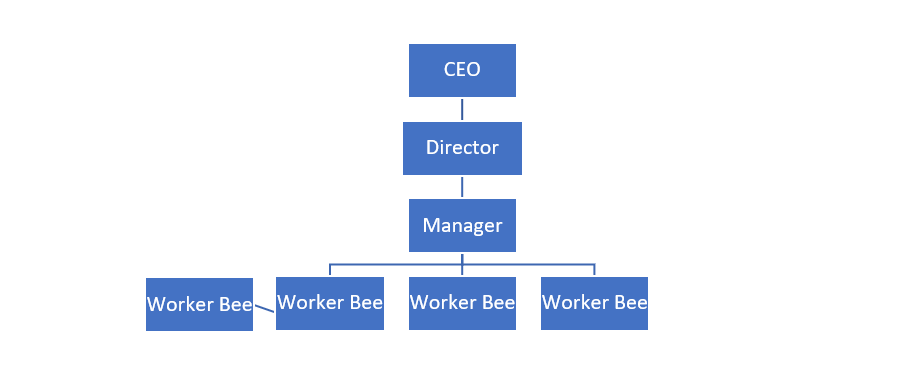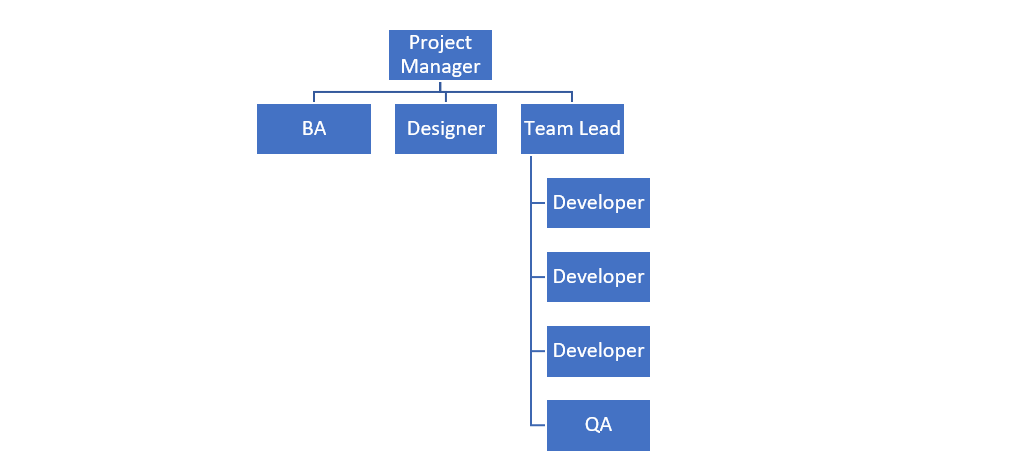Servant Leadership and Elevating Team Engagement
Amanda Deaton | April 12th, 2021

When we think of the leadership within an organization, we typically think of someone sitting in the C-suite, a CEO, a President, a COO because that’s been the standard, what’s been ingrained in our mind. And when you close your eyes, you probably see something like this:

Or in terms of leadership within a project team, you might think of this type of hierarchy:

Regardless of organization, department, or project, the idea is the same – everything starts at the top and rolls down. Over the last 200+ years we’ve seen organizations excel with traditional leadership practices, from monarchies and the military, to 20th and 21st century multi-million-dollar companies. It works when your culture is either:
a. nonexistent or
b. focused solely on market position.
In this style of leadership, we see a ‘top-down’ mindset, where all decisions, all direction are provided from the top and trickle down to team members. We often see the below behavior:
- Decisions are often made in a vacuum and on a whim, with little consideration for employee impact.
- When a decision is met with question or failure, anger ensues.
- Firefighting symptoms without resolving the root cause.
- Minimal employee recognition, as doing great work is seen as part of their job responsibility.
- Few new leaders are developed.
- Overloading of high-performing team members.
- Belief that the higher you are on the organization chart, the more power, more authority you have.
And what are the consequences to the organization?
- Low employee morale
- Lessened employee engagement and job satisfaction
- A heads-down, non-collaborative culture
- High employee turnover
Now, I’m not saying that every company that uses this very “leadership top/down” model falls into these behaviors or sees these consequences. What I am saying is that companies who do not experience these negative consequences (companies with high morale, expanded employee engagement) typically do not exercise traditional leadership styles.
And in my experience, it’s servant leadership manning the helm.
So, what is servant leadership? According to the Greenleaf Institute it “focuses primarily on the growth and well-being of people and the communities to which they belong. While traditional leadership generally involves the accumulation and exercise of power by one at the ‘top of the pyramid,’ servant leadership is different. The servant-leader shares power, puts the needs of others first and helps people develop and perform as highly as possible.” (What Is Servant Leadership)
In a nutshell, a servant leader puts their team first.
Servant leadership is more about behavior than style, it encourages collaborative decision making by those doing the work, by empowering and uplifting those team members. Servant leaders communicate problems and encourage those impacted to resolve the root problem and they continually recognize employee accomplishments, regardless of magnitude. They promote a sense of accountability, open forums of communication, team building, and strive to align a team member’s actions/motivations with overall company vision.

It’s no longer a top-down hierarchical approach to leading, but a peer-to-peer collaborative, supportive mindset.
And what are the results?
- Team members who feel empowered and valued
- Increased team member engagement and performance
- A close-knit, community-like culture
- Team members who are aligned with the company vision
- Decreased turnover
- Improved work/life balance, as team members are less likely to be overloaded
- Trust
- Future leaders are developed
And guess what? This spills over into client interactions too!
So, how do you become a servant leader? It’s not easy, nor is it quick and, as I said before, is a mindset… it starts with the desire to WANT to put people first.
For me, servant leadership started with reading the book The Truth About Employee Engagement by Patrick Lencioni. It made me ask myself how I could better serve my team and how I could increase team confidence. The principles outlined in this book transformed the way I approached management – and it all rests on one common theme… people who are unfulfilled will underperform. Lencioni walks you through a fabled tale to outline why you aren’t getting the most out of the people on your team, why your team morale isn’t where you want it to be.
- Anonymity
- Irrelevance
- Immeasurement
Anonymity
People cannot be fulfilled in their work if they are not known. All human beings need to be understood and appreciated for their unique qualities by someone in a position of authority.
They need to feel that they are a part of something. It’s critical that as leaders we take time to get to know our team members. Sit down with them, find out what’s going on in their lives. And it can’t be disingenuous or fake, it must be genuine. It also must be ongoing. A line that always sticks with me is “no one gets out of bed in the morning to program software… they get out of bed to live their lives and their work tasks are only PART of their lives” (Lencioni). By building these relationships and putting your team member needs first, you’re diving head-first into servant leadership.
Irrelevance
Everyone needs to know that their job matters, to someone. Anyone. Without seeing a connection between the work and satisfaction of another person or group of people, an employee will not find fulfillment.
People need to be needed. They want to know that what they are doing is impactful to someone else. Nobody lives to be self-serving and everyone has a need, a want to serve others in some capacity. It’s our job to ensure the team sees ‘who’ we are helping and ‘how’ we are impacting them. (See my previous blog on overcommunicating project vision 😊) They can then process the fact that they ARE relevant, that what they DO matters. When a team member feels valuable, they will always do more – they will share ideas, they will take on additional responsibilities, they will thrive in terms of the behaviors associated with servant leadership.
Immeasurement
Team members need to be able to gauge their progress and level of contribution for themselves. They cannot be fulfilled in their work if their success depends on the opinions or whims of another person, no matter how benevolent that person may be.
People want to see their impact, their progress without a manager conducting weekly/quarterly, subjective performance reviews. If an employee can gauge their own contribution, their own progress has a greater sense of responsibility and heightened level of engagement. Think of a baseball game. If no stats are recorded, how does a player definitively know their batting average is improving? The answer is they don’t. They can say, ‘I think I’ve had more base hits this week than last’ but this is nothing other than a gut feeling. And subjective. Whether it’s easily seeing your coding velocity week over week or something as simple as counting the number of to-dos you complete for the week, objective measurement leads to job satisfaction, which leads to engaged team members. How does this tie into servant leadership? You are providing the team member with what they need to be successful, and putting them first.
These 3 components all tie back to servant leadership behaviors and the want to put your team members first, to make a difference in their lives. And this is where my servant leadership journey started.
How to start your journey?
My first suggestion is to read the book. It truly puts everything into perspective and provides a foundation for your servant leadership transformation. Next, start to review the characteristics of servant leaders and begin adopting those during your workday. The Spears Center has developed a very thorough list: (Davis).
- Listening
- Empathy
- Healing
- Awareness
- Persuasion
- Conceptualization
- Foresight
- Stewardship
- Commitment to growth of people
- Building community
At the end of the day, leadership has many definitions, many shades, many characteristics. Servant leadership is no different – many different flavors, many different approaches. But one thing remains the same and that is deliberately and thoughtfully putting your team first.
Citations
Lencioni, Patrick. The Truth About Employee Engagement: A Fable About Addressing the Three Root Causes of Job Misery. , 2016. Print.
“What Is Servant Leadership?” Greenleaf Center for Servant Leadership, www.greenleaf.org/what-is-servant-leadership/.
Davis, Paul. “Spears Center for Servant Leadership.” Ten Characteristics of a Servant Leader, www.spearscenter.org/46-uncategorised/136-ten-characteristics-of-servant-leadership.
